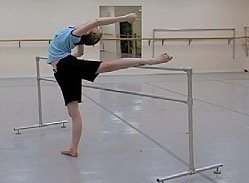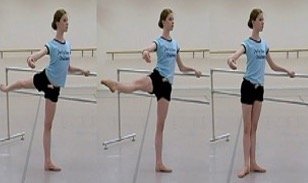Modified Ballet for Fitness and Cross-training
Modified Ballet for Fitness and Cross-training: How About It?
Rising health issues due to modern technology among the young and osteoporosis in the older generation have reduced overall wellness as they interfere with the quality of active daily living and, of course, tend to limit physical activity. In its modified form, Ballet as a fitness activity offers many benefits. However, it tends to encounter generalizations and misconceptions from the public at large, mostly due to its artistic nature, which is usually perceived as ‘ feeling uncomfortable’, especially among males and/or non-dancers.
… It is all about achieving and maintaining correct body alignment and posture, body and spatial awareness, and preventing injuries …
… It is all about improving and/or further refining existing motor skills to enhance overall movement efficiency to optimize and maximize performance… (Schloder, 2016)
Albert Einstein’s famous quote, “Insanity is doing the same thing over and over again and expecting different results”, ought to challenge coaches and athletes at any level to ‘think out of the box’ and look for alternative activities for cross-training to increase all-around athletic abilities or ‘physical literacy’ (Balyi, Way, & Higgs, 2013). However, the artistic and aesthetic nature of ballet frequently encounters misconceptions from the public at large, especially males, who ‘feel uncomfortable’ because of personal perception. Any reference to this activity usually elicits traditional myths and social bias with frequent reactions such as, “Are you kidding me?
…It’s a frilly thing for girls. It’s not masculine!...
…Not my thing!” …“I am not wearing that silly tutu!. ..
…“I am uncomfortable with it and feel really stupid with this stuff!…
… Besides, what does this have to do with my sport anyway? …
Indeed, it has everything to do with ‘your sport’ and some more because the training of physical components in ballet is very beneficial for all sports. In fact, some of the greatest NFL football players in the 1970s participated in ballet. Injured NHL hockey players have credited the same, inclusive Yoga and Pilates, for being able to resume their playing careers. As of late, world- class and Olympic swimmers from the UK have also taken up ballet with strong support from their coach at the University of Loughborough. These elite athletes recognize that dancers not only deserve great admiration for their daily rigorous workout but also for the inherent focus on physical and mental components.
Dancers are some of the most athletic individuals, a fact that is not easily acknowledged within the sports community. A study undertaken by Watson and Garret in the UK at Hertfordshire University reports the results of ten standardized fitness tests from late October 2008. These were administered to dancers of the Royal Ballet, the English National Ballet School, and a squad of national and international British swimmers (including Olympians) in order to construct individual fitness profiles. The test battery included strength, endurance, balance, flexibility, and psychological state, among others. The results: Ballet dancers were fitter, scoring higher on 7 out of 10 test items. Moreover, they were apparently 25% stronger when tested for grip strength. So, do dancers really have better overall fitness levels than elite swimmers? Yes, they do in the case of the samples used in this study.
What can we learn from these results? Obviously, swimming and ballet both offer solid workout opportunities. The fact is that ballet in itself is daily resistance training because the individual’s body weight pushes into the floor during every specific leg exercise while jumping, leaping, hopping, turning, or through other associated dynamic movements. Such activities not only strengthen muscles, but also build up and maintain bone mass and bone density, essential for healthy bone growth. It is now a well-known research fact that impact activities during the early years delay the onset of osteoporosis for both females and males, which swimming – a non-impact activity – does not provide, for example. Bone density in young dancers is known to increase during their developmental years into adolescence and adulthood. Therefore, it only makes sense to examine the total body training concepts within ballet for potential integration into swim programs.
Here are some interesting facts about male athletes in other sports pursuing ballet to enhance their skills. During the 1970s and 1980s, famous NFL Pittsburgh Steelers wide receiver Lynn Swann (1974-1982) and running back Willie Gault, Chicago Bear Super Bowl champion (1983-early 1990s), credited their success on the football field to previous extensive training in ballet. Howard Cosell of Monday Night Football referred to Swann in 1980 as ‘arguably the most graceful receiver’ in NFL history to date, while NBC Sports Curt Gowdy commented during Super Bowl X, “I always thought that what Swann did was a higher form of art than what Baryshnikov is doing.” He referred to Mikhail Baryshnikov, the world-famous Russian dancer who defected to the USA in 1974 while on tour with the Kirov Ballet in Canada and then joined the Winnipeg Royal Ballet. He later became the principal dancer at the New York City Ballet. Swann’s ballet training was well known throughout the league as he always contributed his grace and skills to ballet when he began as an 8-year-old boy (Johnson, Calgary Herald, May 14, 2014). According to the Pinstripe Press, Swann was described in NFL films as “a lethal combination of smooth sipping whiskey and greased lightning... Swann was arguably the most graceful receiver in NFL history. He made more key catches - in more big games - and in more spectacular fashion - than any receiver did. His ballet training enabled him to defy gravity, and his hands were second to none” (Pinstripe Press, cited in Ballet Alert and Funny Face, 2011). Swann played in four Super Bowls, and was inducted into the Hall of Fame and is now on the Board of Directors of the Pittsburgh Ballet Theatre, where he has created a youth scholarship.
Willie Gault, Chicago Bear Super Bowl champion (1983-early 1990s), also a world-class sprinter (Summer Olympics) and bobsledder (Winter Olympics), was called ‘the speed merchant of football’ (Emmerman, 1986). He was referred to as ‘a man for all seasons and the first dancing bear to perform with Chicago’s Ballet’, quoting, “I am not real hung up on the macho aspects of football, ballet is not a sissy sport” (Archive, People, October 13, 1986). Bruce Newman (Sports Illustrated) wrote: “Gault is divided into many parts. Ballet dancer, model, entrepreneur, and track star. Willie Gault also catches passes for the Chicago Bears – when the quarterback throws to him, that is” (November 24, 1986).
These days, more and more athletes in various sports have taken up ballet to improve core stability, body and hip alignment, pelvic stability, and to develop dexterous leg and footwork, to prevent injuries, and for the purpose of rehabilitation. For instance, NHL hockey goalie Ray Emery was told that his playing career was finished due to avascular necrosis of bone components (cellular death, a condition that interrupts the blood supply and affects the hipbone). His daily rehabilitation routine after surgery included ballet, Yoga, Pilates, and swimming to strengthen the core, hip, and thigh muscles. He resumed his playing career for the 2010-2011 season. According to Emery, “I can do things now I could never do before.” Researchers from the Running Injury Clinic at the University of Calgary (Canada) have concluded that runners with knee pain benefit from an intensive hip-strengthening program because it helps to align the hips better with the knees (Ferber, Kendall, & Farr, 2011). The results seemingly support the benefits derived from ballet as an activity as it focuses on core strength and hip and pelvic alignment. It further substantiates Emery’s endorsement as a successful rehabilitation program. Recently, British world-class swimmers have taken up ballet as cross-training and made it part of their Warm-up activity as well.
Here are some of their thoughts about their involvement:
… We’ve been using ballet to warm up before swim sessions, and it works. It really helps to loosen you up, to breathe better, and it gives you a better sense of feel and reach, making you feel ‘longer’ in the water. I can’t say everyone is amazing at it, but that’s not why we’re doing it. Coach Ben Titley likes to think outside the box. He looks at every possible angle when it comes to getting us fit and strong. Posture and flexibility, thinking of how you’re moving as a whole, is really important …
… Ballet is more often seen as the natural partner of synchronized swimmers than racers, but there was no sniggering at Loughborough. It’s unusual, but when Ben suggested it, everyone was really up for it,” swimmer Tancock recalls. “We’re a different group of people in terms of the way we think …
… We’re open to ideas, and using different sports and activities keeps the brain fresh. Ballet is very physical, and you need a lot of strength and precision. They (dancers) make it look effortless, but it requires a lot of concentration. You become more aware of your body and what your limbs are doing, how you’re positioning your limbs, fingers, and toes, states Tancock (2011 World Champion, 50-meter Back Crawl stroke), in C. Lord “Ballet keeps Titley’s company on their toes” … (SwimNews, June 14, 2011).
We modified the exercises (foot positions) from the classical version when performing on stage to suit those seeking fitness benefits. Therefore, many movements are carried out at the ballet barré (bar) for greater support and stability. If the latter is unavailable, the wall or the back of a chair can be used as a creative substitute. Modified footwork and movement sequences from simple to complex, jumps, leaps, and hops (depending on personal ability) develop the muscles of the abdomen, thighs, calves, and ankles. This improves a person’s gait (way of moving, walking, or running), static (standing still), dynamic balance (moving), and protects the knees as well. The focus is always on proper body alignment, strength of the core, neck, and shoulders, and posture correction through remedial exercises. All exercises are carefully selected and adapted for people with injuries, limited movement ability, or those with balance problems.
The world-class and Olympic swimmers at the University of Loughborough in the UK have taken up ballet with strong support from their coach: “It is not our aim to make you a ‘professional dancer’ but rather give you an idea about the value of ballet as a fitness activity to improve your physical abilities, overall movement efficiency, and general wellness” (Schloder 2016).
Schloder, 2024:
I do believe strongly in Robert Frost’s saying:
I took the Road less traveled, and it made all the Difference


